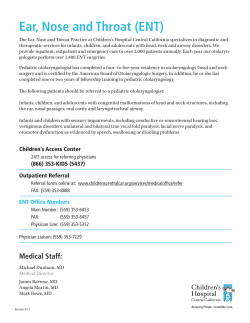
Histology revealed multiple polypoidal mass composed of SUMMARY
001519 NV-19-NASAL:3-PRIMARY.qxd 4/12/10 1:51 PM Page 70 CASE REPORT Nasal Septal Haemangioma in Pregnancy Y Noorizan, MBBCh, H Salina, MS-ORL Department of Otorhinolaryngology, Head and Neck Surgery, Universiti Kebangsaan Malaysia Medical Centre, Jalan Yaakob Latif, Bandar Tun Razak, Cheras 56000 Kuala Lumpur SUMMARY A pregnant lady in her third trimester presented with a rapidly growing right-sided nasal mass associated with epistaxis and nasal obstruction for two months. Examination showed a non tender, protruding mass completely occluding her right nostril. Wide surgical excision was done under local anaesthesia. Histopathology revealed capillary haemangioma. In a gravid patient with a rapidly growing intranasal lesion, capillary haemangioma should be considered as a differential diagnosis. Due to the rapidity of growth, presentation with epistaxis and its macroscopic appearance which often mimics malignancy; histologic confirmation is crucial. KEY WORDS: Haemangioma, Nasal tumour, Pregnancy INTRODUCTION Haemangiomas constitute 7% of all benign tumours and commonly affect children. It is rarely seen in adults. It is characterized by increased numbers of normal or abnormal vessels filled with blood. It can be classified into capillary, cavernous, mixed and hypertrophic types. The majority are superficial lesions commonly found in the head and neck region but can occur internally mainly in the liver. The nasal cavity is an uncommon site for this tumour, whereby 80% arise from anterior nasal septum (Little’s area or Kisselbach’s plexus), and 15% from lateral wall (vestibule, tip of turbinates)1. Other sites include maxillary sinus and roof of nasal cavity. CASE REPORT A 35-year-old Malay lady in her 28th week pregnancy presented to the ENT clinic with intermittent bleeding from her right nostril. She complained of a painless mass which was rapidly increasing in size causing worsening right nasal obstruction for two months. There was no injury or digital trauma to the nose. Examination revealed a protruding, non pulsatile, non tender mass in the right nostril measuring about 1x1cm which completely blocked the anterior nare (Figure 1). It was irregular and ulcerated, which easily bled when manipulated. It had a pedicle with a base about 0.5cm arising from the anterior part of the septum. Rigid nasoendoscopy showed that the nasal cavity posterior to the lesion was normal. No cervical lymphadenopathy was palpable. Examination of the rest of head and neck were unremarkable. The mass was excised under local anaesthesia. Bleeding was secured with diathermy. Primary closure of the mucosal defect was achieved using Vicryl 4/0 suture. Histology revealed multiple polypoidal mass composed of closely packed, interconnecting thin walled vascular spaces lined by endothelial cell. The covering squamous epithelium was ulcerated in places and replaced by acute inflammatory exudate. No evidence of malignancy was seen (Figure 2). The patient recovered completely. There was no evidence of recurrence when seen a year later. DISCUSSION Capillary haemangioma is the most frequent type of haemangioma. Haemangioma in pregnancy is also known as granuloma gravidarum. It is a variant and a polypoid form of capillary haemangioma occurring as a rapidly growing exophytic red nodule attached by a stalk onto skin, gingiva or oral mucosa. It grows to 1-2cm within a few weeks. The prevalence rate varies from 0.5% to 5% in pregnant women2. Commonly it occurs on the maxillary gingiva. Nasal granuloma gravidarum is rare. Typically it presents in multiparous women in the last two trimesters of pregnancy. The classic symptoms are rapidly growing intranasal tumour, epistaxis and nasal congestion. Pain is not characteristic of the lesion. It may ulcerate or be coated with necrotic tissues, making it difficult to distinguish from inverted papilloma, carcinoma or metastatic malignancies1. The etiology of granuloma gravidarum is believed to be due to the massive increase in blood volume during pregnancy and hormonal influences causing extensive vascularization during placentation that subsequently open pre-existing, non patent channels3. The lesion usually involute following termination of pregnancy. Surgical intervention is unnecessary if it doesn’t cause serious problems. However, if there is significant nasal obstruction and epistaxis, and the need to rule out malignancy, complete surgical excision is the treatment of choice. Bleeding is usually secured by diathermy. Other treatment options are silver nitrate, cryotherapy, electrodessication and laser therapy4. A series of 12 patients by El-Sayed Y showed recurrence rate of <10% in capillary haemangioma of the nose5. One case had recurrence due to incomplete excision of the lesion. Other differential diagnoses of vascular lesions of the nasal cavity include benign conditions such as venous haemangioma, haemangioendothelioma, angiomatous glomus tumour, lymphangioma, angiofibroma and malignant conditions such as haemangiopericytoma, haemangiosarcoma, metastatic malignancies. This article was accepted: 15 December 2009 Corresponding Author: Salina Husain, Department of Otorhinolaryngology, Head and Neck Surgery, Universiti Kebangsaan Malaysia Medical Centre, Jalan Yaakob Latif, Bandar Tun Razak, Cheras 56000 Kuala Lumpur, Malaysia Email: drsalina.h@yahoo.com 70 Med J Malaysia Vol 65 No 1 March 2010 001519 NV-19-NASAL:3-PRIMARY.qxd 4/12/10 1:51 PM Page 71 Nasal Septal Haemangioma in Pregnancy Fig. 1: The picture shows the irregular, ulcerated nasal mass obstructing the right nostril. CONCLUSION Haemangioma arising from the nasal septum is uncommon. Its occurrence in pregnancy is very rare. It should be considered a differential diagnosis in a gravid patient with a rapidly growing intranasal mass. As the clinical sign of the lesion often mimics malignancy, excisional biopsy is necessary to confirm the diagnosis by histologic examination. Fig. 2: Numerous well formed capillaries with irregularly contoured vascular channels. (x100) REFERENCES 1. 2. 3. 4. 5. Med J Malaysia Vol 65 No 1 March 2010 Iwata N, Hattori K, Nakagawa T et al. Haemangioma of the nasal cavity. A clinicopathologic study. Auris, Nasus, Larynx 2002; 29: 335-39. Park YW. Nasal granuloma gravidarum. Otolaryngol Head Neck Surg 2002; 126: 591-2. Barter RH, Letteman GS, Schurter M. Haemangiomas in pregnancy. Am J Obstet Gynecol 1983; 87: 625-35. Zarrinneshan AAZ, Zapanta PE, Wall SJ. Nasal pyogenic granuloma. Otolaryngol Head Neck Surg 2007; 136: 130-31. El-Sayed Y, Al-Serhani A. Lobular Capillary Haemangioma (Pyogenic Granuloma) of the Nose. J Laryngol Otol 1997; 111: 941-45. 71
© Copyright 2025





















